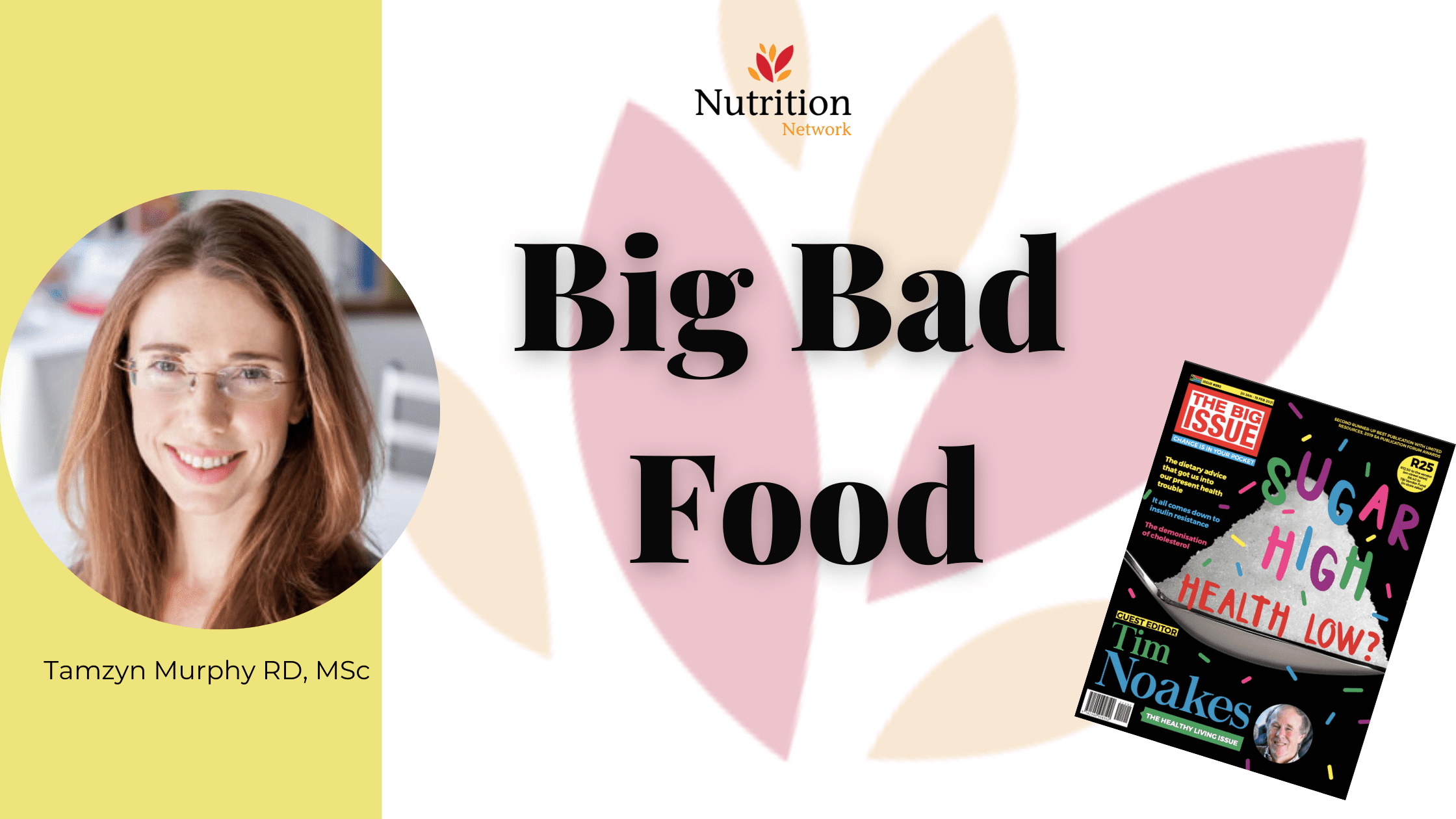
The information in this article published in The Big Issue Magazine (Jan-Feb 21 edition) is not an alternative to medical advice from your doctor or health care practitioner. If you have any specific questions about any medical matter, please consult your doctor or health care practitioner.
If you think you suffer from any medical condition, you should seek medical attention immediately. Please do not delay seeking medical advice, disregard medical advice or discontinue medical treatment because of information in this article.
Big Bad Food
Learn how to spot the danger to make better choices and take your health back.
By Tamzyn Murphy, RD, MSc (Dist.)
Who has the dubious honour of being the wolf-in-Grandma’s-clothing of the food world? You guessed it! Processed and packaged food. The innocuous granny-garments covering our big bad wolf is much like the alluring packaging-shrouding processed food. If you fail to spot the danger in both cases, you’re in peril – by immediate gnashing of teeth or slower and more insidious deterioration of health respectively. Luckily, there are tell-tale signs that give these villains’ game away. You just need to know where to look. The wolf’s tell tale signs are his big eyes, ears and teeth. For processed food it’s all on the label. Train your eye how to spot the danger and you’ll never fall prey to these treacherous disguises again.
Step 1: Presence
Hidden ingredients could affect your health without you knowing. If you are allergic or sensitive to an ingredient then the health effects are immediate and obvious – such as the anaphylactic reaction of someone with a peanut allergy to peanuts, or the headache in some children or migraine sufferers in response to certain additives. But the longer term and less obvious health effects that lead to chronic, metabolic diseases of lifestyle or nutrition (such as heart disease or diabetes – or their precursors, metabolic syndrome and prediabetes) may only be evident when it’s too late, many years down the line. So, relying on how you feel after eating a food may not be the best way to know if it’s good for you. Rather take a look at the most important part of any food label: the ingredient list. If any ingredient is something you don’t want to eat, then don’t eat that product! The most important ingredients to avoid are those that are most likely to send you down the slippery slope to bad health:
- Sugar. Sugar is amongst the worst health-offender, known to contribute to weight gain and the development of most chronic diseases, so avoid it if you can. Sugar by any other name would taste as sweet. And it goes by many names, so don’t be fooled. Look out for the words “sugar”, “sucrose”, ”syrup”, “nectar”, “juice” and anything that ends in “-ose”. Sugar and sweet taste, either alone, or in combination with fat appear to play a big role in giving processed food it’s addictive propensity, making you want to eat more and more.
- Refined carbohydrates. Refined carbohydrates in particular and carbohydrates in general raise blood sugar and are especially problematic if you struggle with weight, metabolic syndrome, prediabetes, diabetes, high blood pressure or heart disease. Look out for and avoid ingredients with “dext-”, “malt-”, or “-ose” in their names. Also avoid or limit refined grains and their flours, such as wheat, maize/corn, rice, rye and barley.
- Polyunsaturated fatty acids (PUFAs). These fats promote inflammation, which is the initiation step of most chronic diseases. The worst offenders come in the form of so-called vegetable and seed oils, such as sunflower, corn and soybean oils.
- Hydrogenated fats. Also avoid any oil that’s been “hydrogenated” as these have been linked to inflammation, heart disease, diabetes and cancer. When choosing oils try to choose cold pressed, virgin options over heat extracted and/or processed (refined, purified, chemically altered/extracted) oils.
- Synthetic additives. These are added to food products to improve flavour, texture, appearance and shelf-life, but their wolfish malice is thinly veiled.
- Artificial flavourings have been shown to be toxic to bone marrow cells in animal studies. Certain artificial colourants precipitate allergic reactions (e.g. Blue 1, Red 40, Red 3, Yellow 5 and Yellow 6), hyperactivity and headaches in some (Tartrazine, Red3, other) and thyroid cancer in animals (Red3, which has consequently been replaced by Red 40).
- Preservatives. Sodium benzoate (found in acidic foods and drinks such as sodas and orange juice), has been shown to aggravate hyperactivity in some children. And when it’s combined with vitamin c (ascorbic acid, e.g in orange juice) it forms a very carcinogenic compound called benzene. It’s also worth avoiding excessive intake of a salty, pink preservative called sodium nitrite (e.g. lunch meats and bacon), though moderate or occasional intake is likely fine. Sodium nitrite is added to meat to prevent bacterial growth. When it’s heated alongside protein they combine to form nitrosamine, which is carcinogenic.
- MSG, aka. monosodium glutamate (flavour enhancer). This savoury flavour enhancer reduces the amount of salt needed. Glutamate increases excitatory neuron firing. While dietary glutamate can’t cross the human blood brian barrier and enter the brain, it can affect peripheral neuron firing and has been implicated in symptoms in some people who may be sensitive to MSG, including headaches, sweating, numbness, tummy trouble.
- Carrageenan (Thickener, emulsifier, preservative). Carrageenan is a red seaweed that’s used in supplements or dairy-like products. It’s negative health effects include gastrointestinal growths and ulcers, and glucose intolerance.
- Soluble fibre fillers (E.g. inulin, guar and xanthan gums). Occasionally an additive has potential health benefits. Soluble fibre is one such case, as it may improve digestion, fullness, and blood glucose and cholesterol control.
- Artificial sweeteners. While artificials sweeteners are generally recognised as safe, some studies cast doubt on the truth of their apparent innocuous nature. Aspartame causes headaches in some people and there are cancer concerns around saccharin, asulfame K, and aspartame. So it’s likely best to limit or avoid these to stay on the safe side. Rather choose the sugar substitutes stevia, monk fruit erythritol or xyltol. Limit other polyol or sugar alcohol sweeteners (that end in “ol”), as they are actually just half sugars. In other words they’re half as sweet as sugar and contain half the calories. Sweet taste alone can be problematic, as it raises insulin(which can worsen insulin resistance and promote fat storage) and has addictive potential in some people.
Step 2: Quantity
Size counts! Titchy teeth are less likely to chomp you. SImilarly, a tiny amount of most bad ingredients inflict less damage to your health. The first place to look when determining quantity is… yes, you guessed it… the ingredient list again. Ingredients are listed in descending order of quantity. In other words the more there is of something, the closer to the beginning of the ingredient list it will appear. The most comes first, the least comes last. If you recognise the first three to five ingredients on the list and are happy to eat them, then go ahead and buy the product.
While the ingredient list should suffice in most cases, for those who want to delve a little deeper into their food choices and health optimising, the nutrition information table adds more nuance to the question of quantity. I don’t suggest worrying too much about the absolute amount (g) of fat or protein in a product, provided it comes from a good, whole or real food source. But you may want to limit carbohydrates if you struggle with weight, metabolic syndrome, prediabetes, diabetes, high blood pressure or heart disease. In these cases, a good rule of thumb would be to choose a food that contains less than 5g of glycaemic carbohydrates per serving. Glycaemic carbohydrates are the ones that raise blood sugar. In South Africa, fibre is defined as any carbohydrate that has a cell wall and is derived from plants (e.g. that found in whole grains, fruit, vegetables). This means that any isolated or synthetic fibres (e.g. inulin and guar gum) shouldnt form part of the total carbohydrate or fibre count on South African products’ nutrition information tables. Fibre can either be soluble (forms a gel like consistency and raises blood sugar about half of what glycaemic carbohydrates do) or insoluble (which is not absorbed from the gut and simply adds bulk to stools).
Total carbohydrate (SA) = glycaemic carbohydrate + fibre
If you are counting carbs then you can either count total or glycaemic carbohydrate, depending on whether you want to be stricter (total) or more lenient (glycemic) with yourself.
Step 3: Quality
In addition to avoiding the baddies discussed in step 1, you can make healthier choices by applying this one overarching principle: Choose real food. Again, look at the ingredient list. If the ingredients have names that you recognise and that resemble whole, real foods (e.g. “macadamia nuts”, “beef”, “strawberries”, or “butter”) then it’s less likely to be hiding a big bad wolf. The more ingredients you recognise the better.
So, get to work spotting those big bad wolves on your pantry and retail shelves before they gobble up your health.
References:
- Department of Health, RSA. Draft guidelines applicable to the draft regulations relating to the labelling and advertising of foods (R429 OF 29 MAY 2014), for compliance purposes.
- Sebastiao C. How to understand food labels in South Africa. Essentials. Apr 2016 https://www.essentials.co.za/lifestyle/how-to-understand-food-labels-in-south-africa
- Canadian Sugar Institute. Carbohydrate and sugar terminology. https://sugar.ca/Sugar-Basics/Carbohydrate-and-Sugars-Terminology.aspx
- FedUp movie. https://bit.ly/fedupinschools
- Food Insight. Sugar alcohols factsheet. International Food Information Council Foundation. Oct 2009 https://foodinsight.org/sugar-alcohols-fact-sheet/
- Gunnars K. Are Vegetable and seed oils bad for your health? Healthline. Apr 2018 https://www.healthline.com/nutrition/are-vegetable-and-seed-oils-bad#section5
- Link R. 12 common food additives – Should you avoid them. Healthline. Apr 2018 https://www.healthline.com/nutrition/common-food-additives#section13
